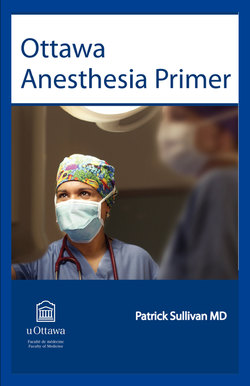Читать книгу Ottawa Anesthesia Primer - Patrick Sullivan - Страница 59
На сайте Литреса книга снята с продажи.
General Anesthesia Induction:
ОглавлениеWith intravenous access secured and appropriate monitoring procedures established, a baseline set of vital signs are recorded. The ‘Preoperative Pause’ should be completed (if this has not already been done), and the need for antibiotics verified. Oxygen is administered by facemask to maximize the oxygen reserve prior to induction of anesthesia (see Chapter 9 Rationale for Pre oxygenation).
Intravenous medications are then administered to the patient to induce a state of general anesthesia. Following induction of anesthesia, loss of consciousness is verified by apnea, loss of response to verbal commands, and loss of the eyelash reflex. Although the patient is asleep, the intravenous medications require an additional period of time to reach their peak effect. During this time, the patient’s lungs are supported with a brief period of bag-mask positive pressure ventilation prior to airway management. Airway management may involve the insertion of a laryngeal mask airway device or similar extraglottic device (see Chapter 8) or insertion of an endotracheal tube (see Chapter 6, 7, 9). Now is the student’s time to shine! Along with establishing intravenous access, bag-mask ventilation of the lungs is one of the most important skills students will acquire during their anesthesia rotation.
The anesthesia machine can be used to provide bag-mask ventilation in an apneic patient. “The circuit” refers to the clear plastic anesthesia tubing that carries oxygen and anesthetic gases from the anesthesia machine to the patient’s airway. It is called a circle breathing circuit because the gas flows in a circle directed by one-way valves. The flow of gas (oxygen) into the circuit is controlled by the gas flow meters. The adjustable pressure release valve (APL) valve controls the pressure at which gas leaves the circuit (provided there is a good seal between the patient’s face and the mask). Prior to induction of anesthesia, ensure the APL valve is fully open (turned counterclockwise). If the APL valve is closed, the patient will not be able to breathe out with a tightly fitting facemask. Ensure the oxygen flow rate is set at ≥ 6 L∙min-1 before applying the facemask. If there is no oxygen flow, the reservoir bag will be collapsed and the patient will experience difficulty breathing.
After induction of anesthesia, a seal must be created between the patient’s face and the anesthesia mask to provide positive pressure ventilation. This is commonly termed ‘bag-mask’ ventilation. Adjust the APL valve by turning the valve clockwise to 20 cmH2O. Airway pressures > 20 cmH2O may result in gastric insufflation and an increase in nausea, vomiting, and potential aspiration (see Chapters 9, 26). Should the reservoir bag become distended and taut, either lift the facemask from the patient to permit passive exhalation or open the APL valve slightly by turning it counterclockwise.
Squeeze the reservoir bag to deliver positive pressure to the patient. When performed correctly, positive pressure will result in oxygen being delivered to the patient’s lungs and the patient’s chest wall will rise. As pressure is released from the reservoir bag, the patient’s chest wall will fall during exhalation, capnography will indicate that CO2 is being exhaled, and the ventilator spirometer will record the volume of gas exhaled by the patient. Common causes of failure of the patient’s chest wall to rise with positive pressure ventilation include a poor facemask seal and / or an upper airway obstruction. Ask your staff anesthesiologist what they do to problem solve when ventilation by facemask fails (see Chapter 6, 8 for maneuvers used to overcome difficulties with facemask ventilation). After insertion of an endotracheal tube or laryngeal mask airway device, ventilation may be controlled using the anesthesia ventilator. The APL valve is only functional during ‘bag-mask’ ventilation and becomes inactive once the ventilator is activated.
